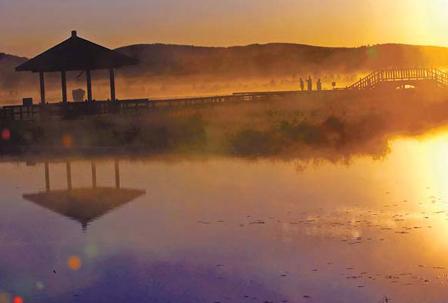In the footsteps of emperors
|
|
|
The Seven Stars Lake looks like a fairyland in the early morning mist. |
A half-open bright red palace door, a tree-lined avenue twisting and turning in the garden and a string of wind chimes swaying from the eaves - they all inspire a look into the past.
Compared to the quiet nights, the busy, noisy days at the Puning Temple and Putuo Zongcheng Temple have a different charm.
At the temples, it's common to see thousands of devotees spin prayer wheels or mutter scriptures under their breath with all their hopes and aspirations on their faces.
Puning Temple was built by the Emperor Qianlong, the grandson of Kangxi. It was modeled after the Samye Monastery, a sacred Lama site in the Tibet autonomous region. Putuo Zongcheng Temple, more popularly known as little Potala Palace, is a smaller replica of the famous Tibetan complex.
Both Tibetan-style temples are now part of the World Cultural Heritage-listed Eight Outer Temples built by the Manchu court to welcome and accommodate leaders of religious and ethnic groups.
In the past, only high officials and nobles were allowed to enter the royal temples and the resort. These days, the entrance criteria are more democratic and plenty of visitors in sunglasses and T-shirts wander the grounds in a right royal way.
While I was climbing up the steep steps leading up to the 43-meter-high platform in Putuo Zuocheng Temple, I passed a French tourist in a wooden sedan chair carried by two strong local bearers. She smiled happily and told me it cost her just 80 yuan ($11.8) for the round trip up and down.
Not too far away at the base of the steps, a little booth displayed a whole wardrobe of Qing Dynasty costumes. For 10 yuan, you can dress up and take a picture.
A young lady chose a Manchurian princess' red outfit and put on a matching headdress. When she elegantly strolled in the grounds of the 300-year-old palace, it seemed time had warped and we were back in history.
Once you have successfully navigated the steps up, there is the gilt-roofed Wanfa Guiyi Palace. Tourist guides often tell this story: When the invading Japanese army wanted to scrape away the gold from the roof, two soldiers mysteriously toppled off to their deaths. The attempt stopped.
Some of the resort's memories are dark and painful, but the natural beauty of the scenic Bashang Grassland can provide some relief.
It is a three-hour bus ride from Chengde, and when we arrived it was near evening. The cloud-studded twilight sky and the soft fading light created a spectacular view of the prairie.
But, local residents say the most beautiful time to see the grasslands is early morning, so after a warm bonfire party that night, we went to bed and set the alarm for 4 am.
The early bird catches the worm, they say. In our case, we had booked the hotel's only rental car and our party of four were heading off while most of the other visitors were still tucked up in bed. Our destination was the Seven Stars Lake, a wetland park named after the constellation, the Big Dipper.
It was an unforgettable wonderland. Thin veils of early morning fog floated on the large lake, which was surrounded by vast areas of verdant grass. A couple of slowly-turning windmills and a long wooden walkway slowly appeared as the mist lifted.
My guide book says Kangxi, who loved hunting in the grasslands, was initially attracted by this same landscape and was so inspired that he decided he wanted his summer resort built nearby. It was thus a fitting place to end our journey - in his imperial footsteps.
 0
0 








Go to Forum >>0 Comments